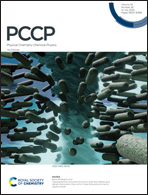Autocatalytic decomposition of energetic materials: interplay of theory and thermal analysis in the study of 5-amino-3,4-dinitropyrazole thermolysis†
Abstract
A reliable kinetic description of the thermal stability of energetic materials (EM) is very important for safety and storage-related problems. Among other pertinent issues, autocatalysis very often complicates the decomposition kinetics of EM. In the present study, the kinetics and decomposition mechanism of a promising energetic compound, 5-amino-3,4-dinitro-1H-pyrazole (5-ADP) were studied using a set of complementary experimental (e.g., differential scanning calorimetry in the solid state, melt, and solution along with advanced thermokinetic models, accelerating rate calorimetry, and evolved gas analysis) and theoretical techniques (CCSD(T)-F12 and DLPNO-CCSD(T) predictive quantum chemical calculations). The experimental study revealed that the strong acceleration of the decomposition rate of 5-ADP is caused by two factors: the progressive liquefaction of the sample directly observed using in situ optical microscopy, and the autocatalysis by reaction products. For the first time, the processing of the non-isothermal data was performed with a formal Manelis–Dubovitsky kinetic model that accounts for both factors. With the aid of quantum chemical calculations, we have rationalized the autocatalysis present in the formal kinetic models at the molecular level. Theory revealed an unusual primary decomposition channel of 5-ADP, viz., the two subsequent sigmatropic H-shifts in the pyrazole ring followed by the C–NO2 bond scission yielding a pyrazolyl and nitrogen dioxide radicals as simple primary products. Moreover, we found the secondary reactions of the latter radical with the 5-ADP to be kinetically unimportant. On the contrary, the substituted pyrazolyl radical turned out to undergo a facile addition to 5-ADP, followed by a fast exothermic elimination of another ˙NO2 species. We believe the latter process to contribute remarkably to the observed autocatalytic behavior of 5-ADP. Most importantly, the calculations provide detailed mechanistic evidence complementing the thermoanalytical experiment and formal kinetic models.



 Please wait while we load your content...
Please wait while we load your content...